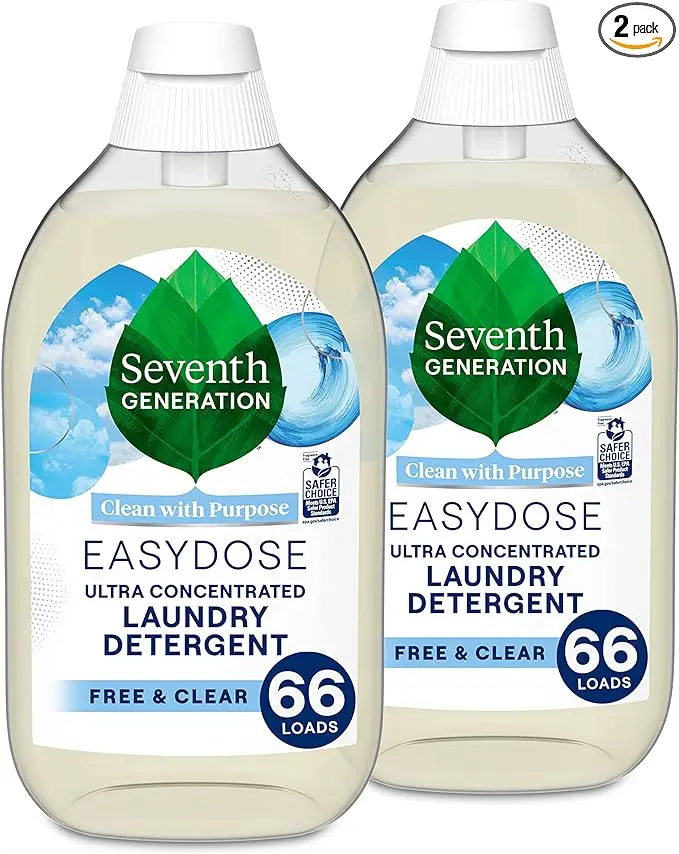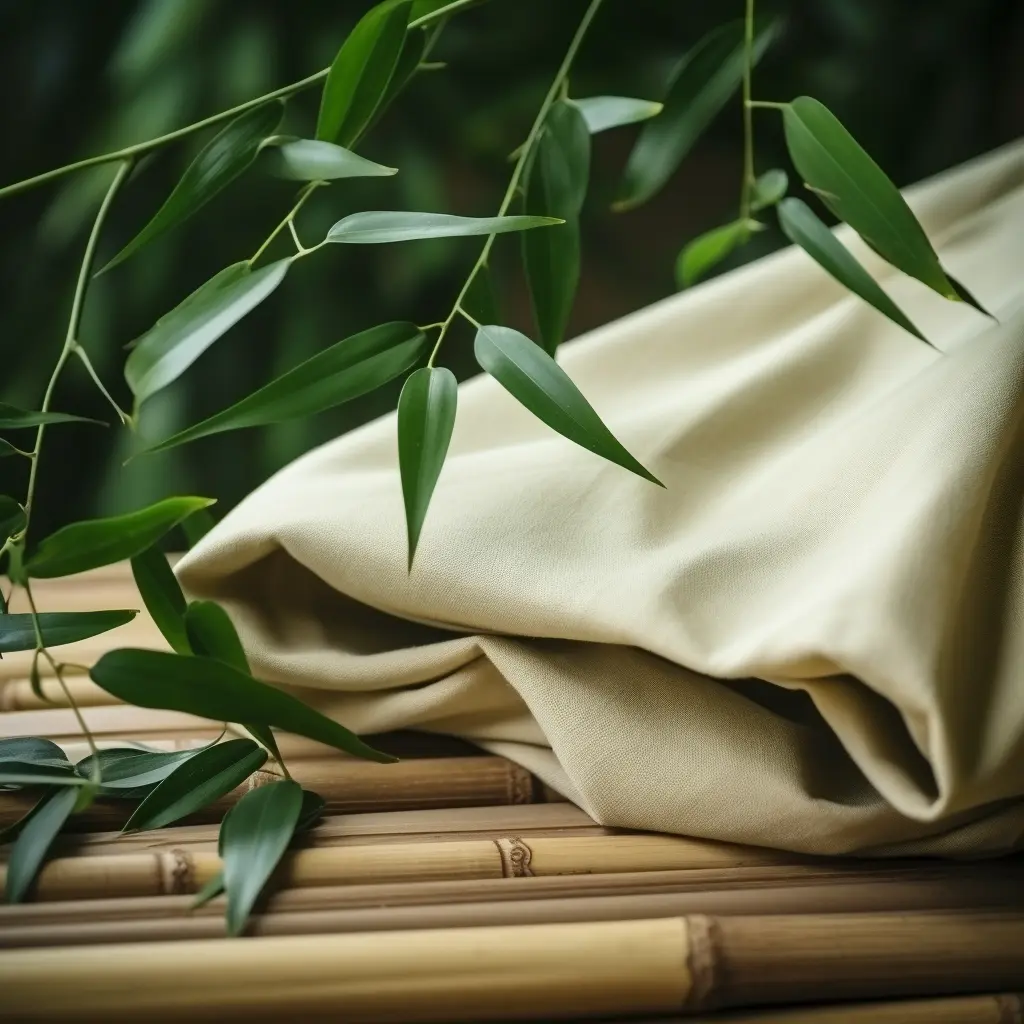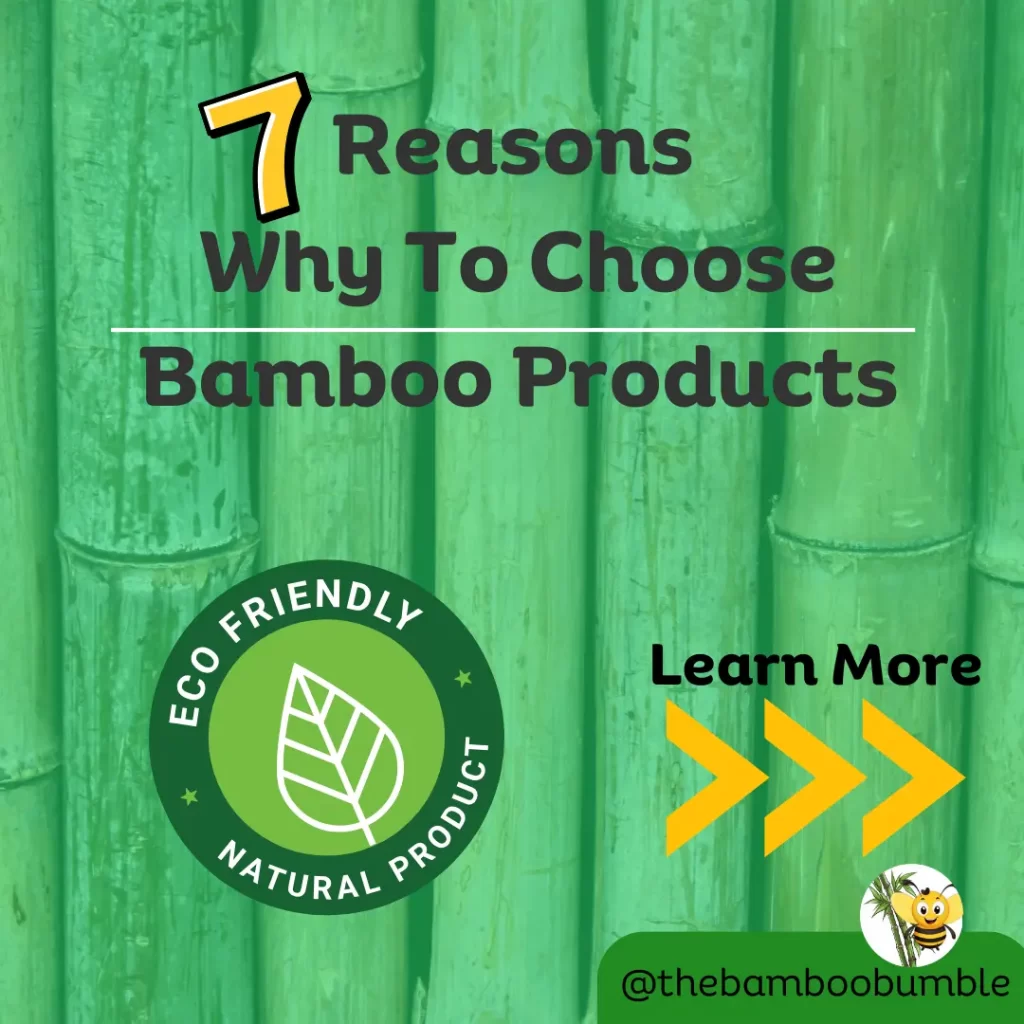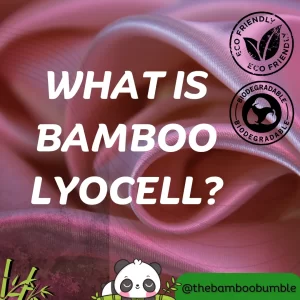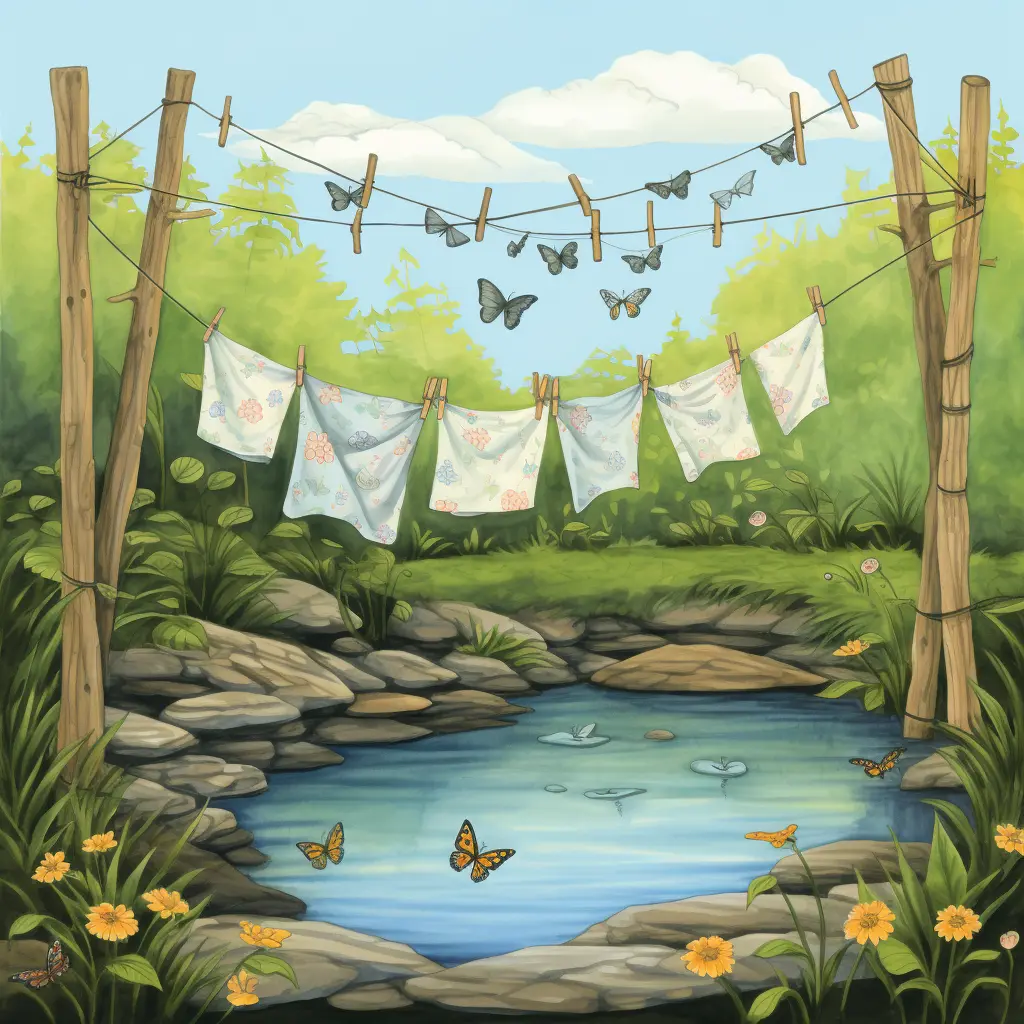
The Guide to Washing Bamboo Baby Clothes
If you’re looking for the right way to care for your baby clothes made from bamboo fabric, you’re in the right spot. 🌱👕 This is THE guide to washing bamboo baby clothes. Within this article lies the wisdom to not only cleanse these delicate garments but to serve your little one with the gentlest of touches. You understand the significance of nurturing and protecting, and this guide will empower you to extend that dedication to the very fibers your baby’s clothes are woven from. As you immerse yourself in the step-by-step process, drying, and post-wash instructions, you’ll also gain insights into the eco-impact of your laundering practices. By the end, you’ll be equipped to wash bamboo baby clothes with a heart full of care and hands skilled in sustainability. 🍃💧
NOTE: Before diving into the washing process, it’s crucial to check the manufacturer’s care label on your bamboo baby clothes. Different brands may have specific recommendations for washing and drying, which are essential to follow to maintain the integrity and quality of the fabric. Adhering to these guidelines ensures that you provide the best care for your baby’s garments, tailored to their specific needs.
Table of Contents
Let’s just get into it!
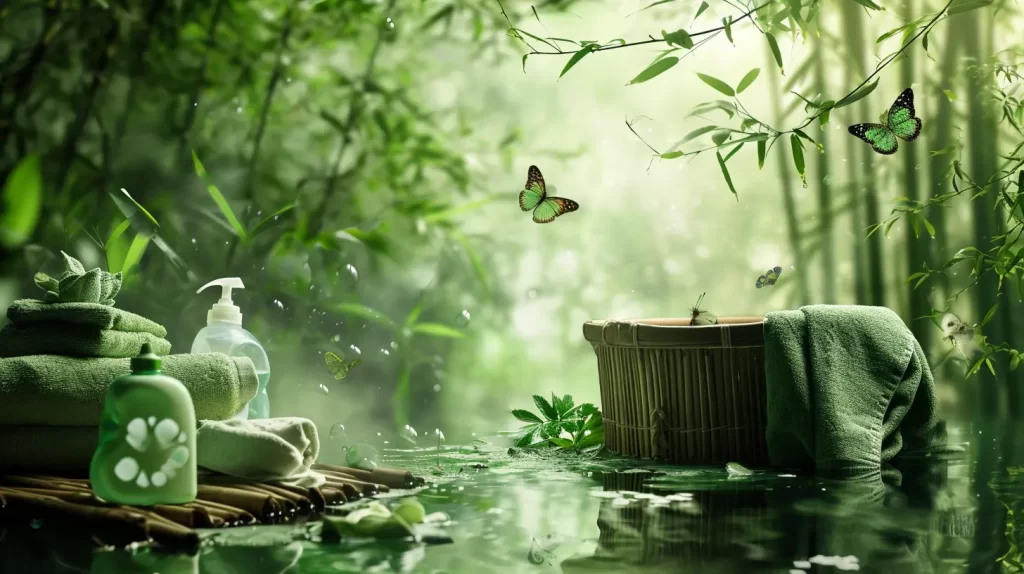
Preparing to Wash Your Bamboo Baby Clothes
Proper preparation is key to keeping your bamboo baby clothes in their best condition. This natural fabric requires a gentle approach, starting from the moment you sort them for washing. Here’s a more comprehensive guide to help you get ready:
- Sorting with Care: Begin by separating your bamboo baby clothes by color to prevent color bleeding. Additionally, sort them by fabric weight. Delicate items should be washed with similar fabrics to avoid damage from harsher materials during the wash cycle.
- Inspect Each Garment: Examine each piece for loose threads, buttons, or embellishments that might come off or cause tangling. Fasten any buttons or zippers to prevent them from snagging other garments. Turn the clothes inside out to protect the outer surface from abrasion and fading. 🔍
- Pocket Check: Ensure all pockets are empty. Objects like coins, keys, or even tissues can cause unexpected damage or staining during the wash.
- Stain Pre-Treatment: Address any visible stains before washing. Use a gentle, eco-friendly stain remover that’s safe for bamboo fabrics. Apply it carefully according to the instructions, usually by dabbing rather than rubbing to avoid fiber damage. 🩹
- Handwashing Precautions: For especially delicate items, consider hand washing. Fill a basin with cold water and a small amount of mild detergent, gently swishing the clothes in the water rather than wringing or scrubbing them.
- Pre-Wash Soaking: For heavily soiled garments, a brief soak in cold water with a bit of detergent can help loosen dirt and stains. This step is especially useful for items like bibs or play clothes that might have more challenging stains.
- Gentle Detergent Selection: Choose a detergent that’s specifically designed for delicate fabrics and is eco-friendly. These detergents are less likely to contain harsh chemicals that can degrade bamboo fibers and irritate your baby’s skin.
By following these steps, you’re not just washing clothes; you’re preserving the softness, color, and structure of each bamboo garment. This mindful preparation ensures that your bamboo baby clothes remain a cozy, durable choice for your little one.
Selecting the Right Laundry Detergent for Bamboo Fabric
When it comes to washing bamboo baby clothes, the choice of detergent plays a pivotal role in ensuring the fabric’s softness and longevity. Here’s an expanded guide to help you select the most suitable laundry detergent for bamboo fabrics. 🌿
- Understand Bamboo Fabric Needs: Bamboo is a unique material that requires special care. It’s naturally soft, hypoallergenic, and has antibacterial properties. Using the wrong detergent can strip away these natural benefits.
- Chemical-Free Formula: Look for detergents that are free from harsh chemicals such as chlorine, bleach, and optical brighteners. These substances can weaken bamboo fibers over time and may cause skin irritation for your baby.
- Eco-Friendly Options: Prioritize eco-friendly detergents that are not only gentle on the fabric but also kind to the environment. Biodegradable formulas with plant-based ingredients are a great choice, ensuring that your washing process has minimal environmental impact.
- Fragrance-Free or Mildly Scented: Fragrances in detergents, even if they are derived from natural sources, can be harsh on sensitive skin. Opt for a fragrance-free detergent or one with a very mild, natural scent to keep your baby’s clothes fresh without the risk of irritation.
- Liquid vs. Powder Detergents: Liquid detergents are generally preferred for bamboo fabrics as they tend to dissolve more efficiently in water and are less likely to leave residue on the clothes. If you choose powder detergent, ensure it’s finely milled and dissolves completely in water.
- Neutral pH Balance: A detergent with a neutral pH balance is gentler on bamboo fabrics and helps maintain their natural softness and texture. Acidic or highly alkaline detergents can alter the bamboo fibers, affecting the fabric’s feel and durability.
- Gentle on Delicates: Seek out detergents labeled as suitable for delicate fabrics. These are formulated to clean effectively without being overly aggressive, which is perfect for preserving the integrity of bamboo clothing.
- Dosage Recommendations: Follow the recommended dosage on the detergent label. Using too much detergent can leave a residue that stiffens the fabric, while too little may not clean effectively.
By carefully selecting a laundry detergent that aligns with these criteria, you can help ensure that your bamboo baby clothes remain soft, comfortable, and durable for a longer time, while also respecting your baby’s skin and the environment.
Step-by-Step Process to Wash Bamboo Baby Clothes
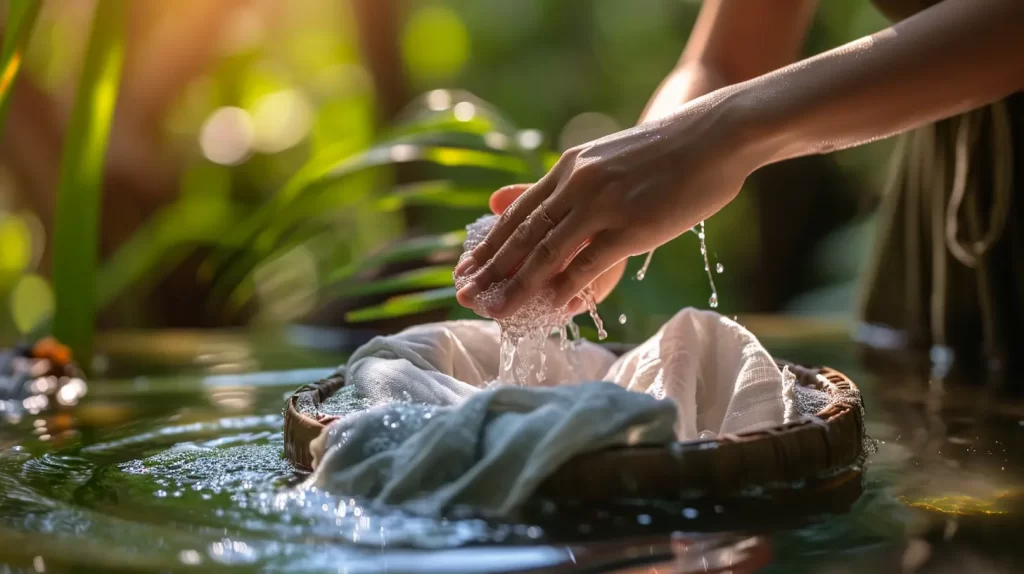
Now that you’re familiar with the basics, let’s tackle the actual steps to ensure your bamboo baby clothes remain soft and durable. You’ll need to know the best wash cycle to use and how to deal with those inevitable stains. Read on for clear instructions that’ll keep your little one’s garments looking their best.
Optimal Wash Cycle for Bamboo Baby Garments
Properly washing bamboo baby garments is crucial for retaining their inherent softness and durability. The right wash cycle and care can significantly extend the life of these delicate items. Here’s an expanded guide to help you master the optimal wash cycle for bamboo baby garments:
- Preparation: Start by turning each garment inside out. This simple step helps protect the outer surface of the fabric from friction and abrasion during the wash cycle, preserving colors and textures.
- Choosing the Right Wash Cycle: Select a gentle or delicate cycle on your washing machine. These settings are specifically designed for fragile fabrics, using lower spin speeds and reduced agitation to gently cleanse without causing damage.
- Water Temperature: Always use cold water when washing bamboo garments. Hot water can cause bamboo fibers to shrink and can weaken the integrity of the fabric. Cold water is effective at cleaning while being gentle on the fabric.
- Stain Treatment: Before washing, treat any visible stains with a gentle, eco-friendly stain remover. Apply the remover directly to the stains and follow the product’s instructions for best results. This pre-treatment is essential for removing tough stains without harming the bamboo fibers.
- Detergent Selection: Use a mild, eco-conscious detergent that’s specifically formulated for delicate fabrics. These detergents are gentle on bamboo fibers and help maintain the fabric’s natural softness and strength. Avoid detergents with harsh chemicals or strong fragrances.
- Avoiding Harsh Chemicals: Fabric softeners and bleach should be avoided when washing bamboo clothes. Fabric softeners can coat and weaken the fibers, reducing the material’s breathability and absorbency. Bleach is too harsh for bamboo fabrics and can lead to fiber breakdown and discoloration.
- Loading the Washer: Don’t overcrowd the washing machine. Bamboo clothes need space to move freely in the water for thorough cleaning. Overloading can result in uneven washing and excessive wrinkling.
- Final Rinse and Spin: Ensure your machine performs a gentle final rinse and spin to remove any detergent residues without stressing the fabric.
By following these steps, you can ensure your bamboo baby garments are washed optimally, keeping them as soft and durable as possible for your little one’s comfort and well-being.
First-Time Washing of Bamboo Baby Clothes
Time for the first wash of those adorable bamboo baby clothes? 👶🌿 This milestone is more than just a laundry task; it’s about preserving the charm and comfort of your little one’s first wardrobe. Let’s walk through some essential tips to ensure that first wash is as gentle and effective as possible.
The Golden Rules for the First Wash 💦
- Color Me Careful: Bamboo fabrics are known for their vibrant colors, but they need a little extra care in the first wash. Start by washing similar colors together to avoid any color bleeding mishaps. Think of it like sorting through a rainbow, ensuring each hue stays true. 🌈
- The Cold Water Embrace: Embrace cold water for this inaugural wash. Hot water is a no-go as it can cause shrinking and fading. Cold water maintains the fabric’s integrity, keeping everything snug and vibrant. ❄️
- Gentle Cycle, Gentle Care: Opt for the gentle or delicate cycle on your washing machine. It’s like a soft lullaby for the clothes, cleaning them without any harsh agitation.
- Detergent Matters: Choose an eco-friendly, mild detergent. This first wash sets the tone for the fabric’s future, so let’s keep it free from harsh chemicals. A gentle detergent is like the first spoonful of baby food – mild and nourishing. 🍃
- Spot Check: Got a stain? Treat it with a mild, eco-friendly stain remover before the wash. Remember, it’s about being gentle – dab, don’t rub, to protect the delicate bamboo fibers.
- The Drying Debut: When it’s time to dry, air drying is your best friend. Lay the clothes flat or hang them up, but keep them out of direct sunlight. It’s like giving the fabric a gentle hug, preserving its softness and shape. ☀️
Extra Tips for That First Wash
- Pre-Wash Inspection: Give each item a quick but thorough check. Look for any loose threads or buttons and secure them. It’s like babyproofing – but for clothes!
- Inside Out Advantage: Turn the clothes inside out. This helps protect the outer surface and ensures the inside gets a thorough clean.
- Avoid Overloading: Don’t overcrowd the washer. Bamboo clothes like a little space to swirl and dance in the water, ensuring an even and effective wash.
- The Final Rinse: Consider an extra rinse cycle to ensure all detergent is washed away. It’s like a double-check, making sure nothing but softness touches your baby’s skin.
By following these tips, your bamboo baby clothes’ first wash will set the stage for a long life of coziness and color. Remember, this first wash is more than a chore; it’s the first step in caring for the fabrics that cuddle your baby every day. Happy washing! 🌱👕💧
Tips for Washing Bamboo: Stain Removal and More
Effective washing of bamboo baby clothes extends beyond mere stain removal. It involves a series of steps tailored to preserve the integrity and appearance of the fabric. Here’s an enhanced guide for a comprehensive washing process, ensuring your bamboo garments remain in pristine condition.
- Inside Out: Always turn bamboo garments inside out before washing. This helps in protecting the outer surface from direct exposure to detergent and mechanical action, thus preserving the colors and textures.
- Machine Settings: Load your bamboo baby clothes into the washing machine and select the gentle or delicate cycle. This cycle uses a milder wash action and spin, which is essential for preserving the softness and structural integrity of bamboo fabrics.
- Temperature Control: Use cold water for washing. Hot water can cause shrinking, fading, and weakening of the bamboo fibers. Cold water is gentle, effective, and energy-efficient.
- Detergent Choice: Select a mild, eco-friendly detergent specifically suited for delicate fabrics. These detergents are free from harsh chemicals and are less likely to cause irritation to your baby’s skin or damage to the environment.
- Stain Treatment: If you have pre-treated stains, ensure the stain remover is thoroughly rinsed out during the wash cycle. Gentle dabbing rather than scrubbing is recommended for spot treating stains to preserve the fabric’s texture.
- Load Size: Avoid overloading the washer. Bamboo clothes need adequate space to move in the water for thorough cleaning. Overcrowding can lead to ineffective washing and increased wrinkling.
- Post-Wash Care: As soon as the wash cycle is complete, promptly remove the bamboo clothes. This reduces the chance of wrinkles setting in and makes subsequent drying more efficient.
- Drying Method: Air-dry the garments on a flat surface or hang them up to dry. This method is gentle on the fabric and eco-friendly. Ensure that they are dried in a shaded area to prevent sun damage.
- Using a Dryer: If you must use a dryer, select a low heat setting. High heat can cause shrinkage and may weaken the bamboo fibers over time. Remove the clothes while they are slightly damp to prevent overdrying.
By following these enhanced tips, your bamboo baby clothes will not only be clean but also maintain their softness, shape, and color, making them a long-lasting and comfortable choice for your baby.
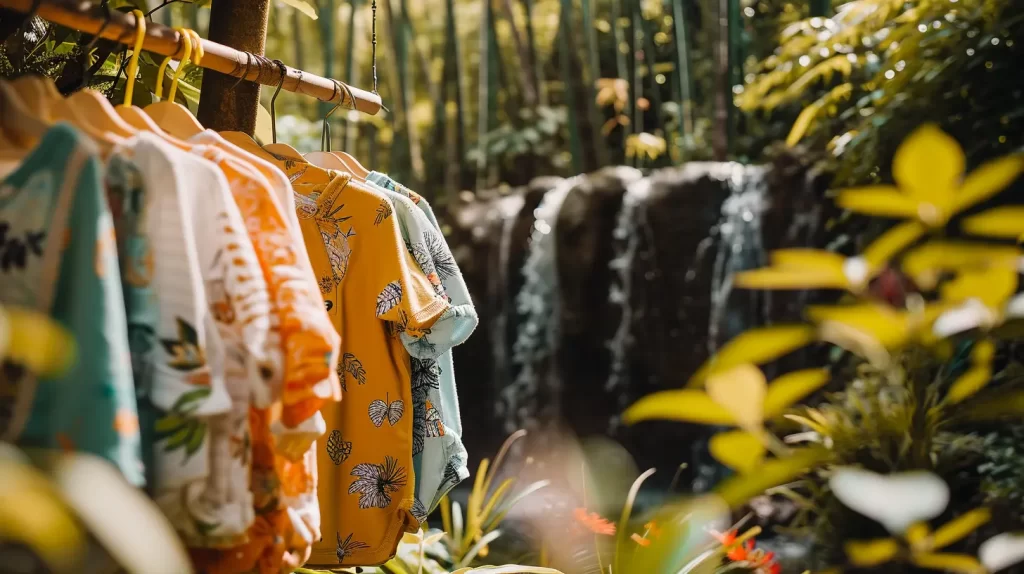
Expert Tricks for Tackling Common Baby Stains on Bamboo Clothes
Got some stubborn stains on those cute bamboo outfits? No worries! Every parent faces the occasional oopsie, but fear not, we’ve got some eco-friendly, fabric-friendly tricks up our sleeves! From food smears to the inevitable diaper mishaps, here’s how to tackle those common baby stains while keeping those bamboo threads as good as new. 🌱✨
1. Food Fiascos:
- Purees and Baby Food: Mix a bit of eco-friendly detergent with cold water and gently dab on the stain. For the stubborn bits, let it sit for a few minutes before a gentle wash.
- Fruit Juices: Cold water is your best friend here. Soak the stained area before washing, and consider a bit of lemon juice or white vinegar for an extra eco-friendly kick.
2. Formula Challenges 🍼:
- General Approach: Mix a solution of cold water and a gentle, eco-friendly detergent. Gently apply it to the stain and let it work its magic for a few minutes. A soft brush can be used for gentle agitation.
- Persistent Spots: For those tough-to-remove formula stains, soaking the garment in cold water with a bit of baking soda can help lift the stain before washing.
3. Diaper Disasters:
- The Initial Clean: Rinse the garment in cold water as soon as possible. This helps prevent the stain from setting.
- Stain Treatment: Apply a mixture of cold water and eco-friendly detergent directly on the stain. For more stubborn stains, a gentle, eco-friendly stain remover can be a lifesaver.
4. Mud and Outdoor Fun 🌻:
- Pre-Wash Rinse: Shake off any loose dirt and rinse the garment under cold water.
- Gentle Scrub: Apply a small amount of eco-friendly detergent and gently scrub with a soft brush. Let it sit for a few minutes before tossing it into your usual wash.
Remember, the key to effective stain removal on bamboo baby clothes is acting quickly and using gentle, eco-friendly products. These methods not only keep the clothes looking adorable but also contribute to a healthier planet. 🌍💚 Happy cleaning!
Drying and Ironing: Preserving the Integrity of Bamboo Clothes
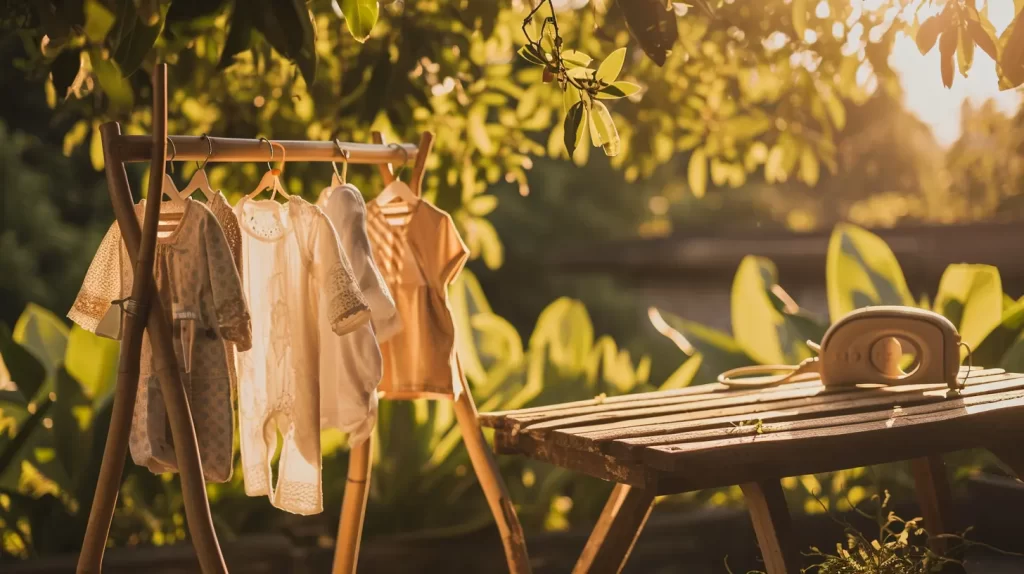
After you’ve washed your bamboo baby clothes, it’s crucial to dry them properly to maintain their softness and durability. You’re faced with a choice between air drying and machine drying – each has its own impact on the fabric’s integrity. When it comes to ironing, you’ll need to know the right techniques to prevent damage and keep those adorable outfits looking their best.
Air Drying vs. Machine Drying Bamboo Baby Clothes
Drying bamboo baby clothes properly is as crucial as washing them correctly. The method you choose for drying has a significant impact on the fabric’s longevity, softness, and overall quality. Here’s an expanded guide to help you understand the pros and cons of air drying versus machine drying, enabling you to make the best choice for your bamboo garments.
Air Drying Bamboo Baby Clothes
Air drying is the kindest method for bamboo fabrics, as it naturally preserves the fibers’ integrity and softness:
- Preservation of Quality: Air drying avoids the stress and wear that can come from the tumble of a dryer. It helps maintain the fabric’s natural texture, color, and durability.
- Energy Efficiency: This method is energy-efficient, reducing your carbon footprint and utility bills. It’s an eco-friendly choice that aligns with the sustainable nature of bamboo fabric.
- Gentle on Skin: Air-dried clothes remain free from the potential residue that can sometimes be left by dryers, making them ideal for sensitive baby skin.
- Method: Lay the garments flat on a clean, dry surface or use a drying rack. If hanging, avoid using metal hangers that can leave rust marks. Instead, opt for wooden or plastic hangers.
- Location: Choose a well-ventilated area away from direct sunlight to prevent fading and weakening of the fibers.
Machine Drying Bamboo Baby Clothes
Machine drying offers convenience but requires careful consideration to minimize potential damage to bamboo fabric:
- Time-Saving: A dryer can save time and is useful in humid climates where air drying might take too long.
- Risk of Damage: High temperatures and tumbling can cause shrinkage, wear, and tear over time. Repeated machine drying can lead to a loss of softness and breakdown of fibers.
- Low Heat Setting: If machine drying is necessary, always use the lowest heat setting. Remove the clothes while slightly damp to prevent over-drying.
- Dryer Sheets and Softeners: Avoid using dryer sheets and fabric softeners, as they can leave a residue and diminish the bamboo fabric’s natural qualities.
Ironing Bamboo Baby Clothes
Ironing bamboo fabric is generally not required due to its natural smoothness:
- Low Heat Ironing: If ironing is necessary, use the lowest heat setting and iron on the reverse side of the fabric.
- Use a Pressing Cloth: Place a thin cloth between the iron and the bamboo garment to protect the fabric.
- Avoid Steam: Excessive moisture from steam can harm the bamboo fibers.
In summary, while air drying is the preferred method for maintaining the quality of bamboo baby clothes, machine drying on a low heat setting can be used judiciously. Each method has its place, and understanding their respective impacts will help you keep your bamboo baby clothes in optimal condition for longer.
How to Iron Bamboo Fabrics Safely
Ironing bamboo fabrics requires a delicate approach to ensure the material’s unique qualities are not compromised. Here’s an expanded guide on how to safely iron bamboo baby clothes, preserving their softness, shape, and longevity:
- Understanding Bamboo’s Sensitivity: Recognize that bamboo is a delicate fabric. Its fibers can be damaged by high heat, which can lead to loss of softness, sheen, and overall integrity. This sensitivity necessitates a careful ironing approach.
- Iron Setting: Adjust your iron to the lowest heat setting suitable for delicate fabrics, typically marked as ‘synthetic’ or ‘rayon’. This gentle heat is enough to smooth out wrinkles without damaging the fibers.
- Ironing Damp Fabrics: Ideally, iron bamboo fabrics while they are slightly damp. This helps in releasing wrinkles more easily and reduces the need for high heat. If the fabric is already dry, lightly mist it with water before ironing.
- Using a Pressing Cloth: Place a thin cotton cloth, like a handkerchief or a pressing cloth, between the iron and the bamboo garment. This acts as a buffer, protecting the fabric from direct contact with the iron and distributing the heat more evenly.
- Gentle Techniques: Glide the iron gently over the fabric without exerting too much pressure. Continuously moving the iron prevents overheating in one area, which can scorch or burn the delicate bamboo fibers.
- Avoiding Steam: While steam can be beneficial for many fabrics, it’s best avoided with bamboo. Excess moisture can distort the fibers and potentially cause shrinkage or warping.
- Post-Ironing Care: After ironing, hang the garment or lay it flat to cool down. This helps set the shape and ensures the smoothness achieved from ironing lasts longer.
- Testing First: If unsure about the correct setting, test the iron on a small, inconspicuous area of the fabric first. This precaution can prevent any unexpected damage to the garment.
By adhering to these guidelines, you can safely iron your bamboo baby clothes, keeping them looking crisp and fresh while maintaining their natural softness and comfort for your baby’s delicate skin.
Post-Wash Care Instructions for Bamboo Baby Garments

Once your bamboo baby clothes are clean and dry, it’s important to store them properly to maintain their softness and durability. You’ll need to follow a few simple routine maintenance steps to ensure they last. Let’s explore how to keep your bamboo garments in top condition for your little one’s comfort.
Storing and Maintaining Your Bamboo Baby Clothes
Proper storage and maintenance of bamboo baby clothes are essential steps in preserving their quality and ensuring they remain soft and durable over time. Here’s an expanded guide on how to best care for these garments post-wash:
- Gentle Folding: Bamboo fabrics are known for their softness and flexibility, but they still require careful handling. Fold the clothes gently, smoothing out any wrinkles with your hands. Avoid pulling or stretching the fabric, as this can lead to misshaping or loosening of the fibers.
- Avoiding Compression: While storing, try not to stack too many items on top of each other. Excessive weight can compress the fibers, potentially leading to permanent creasing. Instead, give each piece some breathing room.
- Cool and Dry Storage: Store your bamboo baby clothes in a cool, dry place. Excessive heat or humidity can damage the fabric, causing it to degrade over time. A drawer or closet that maintains a consistent temperature is ideal.
- Sunlight Considerations: Direct sunlight can cause the colors in bamboo fabrics to fade. When choosing a storage spot, opt for an area away from direct sun exposure. This will help keep the colors vibrant for a longer duration.
- Using Natural Moth Repellents: To protect the clothes from moths and other pests, use natural repellents like cedar blocks or lavender sachets. These not only keep the pests away but also impart a subtle, pleasant scent without the use of chemicals.
- Regular Checks: Periodically check your stored bamboo clothes for any signs of damage or unwanted pests. This routine inspection can help you address any issues before they become problematic.
- Breathable Containers: If you’re using containers or storage boxes, ensure they are made of breathable materials like cotton or linen. Plastic containers can trap moisture, which might lead to mildew or fabric degradation.
- Seasonal Rotation: If certain bamboo garments are not in use for an extended period (like seasonal items), consider rotating them within your storage space. This practice prevents any long-term pressure points on the fabric and keeps all items in good condition.
By following these detailed steps for storing and maintaining your bamboo baby clothes, you can significantly extend their lifespan, ensuring they remain a comfortable and cherished part of your little one’s wardrobe.
Routine Maintenance to Keep Bamboo Clothes Made to Last
Ensuring that your bamboo baby clothes last through countless cherished moments involves a commitment to routine maintenance post-wash. This ongoing care is key to preserving the fabric’s softness, durability, and color. Here’s an enhanced guide to help you effectively maintain your bamboo garments:
- Reshaping Post-Wash: Once the washing cycle is complete, take a moment to gently reshape each bamboo garment. This is best done while the clothes are still damp. Carefully smooth out any wrinkles and reshape any stretched areas to restore the original fit and look.
- Optimal Drying Techniques: Air-drying is the most fabric-friendly method for bamboo clothes. Lay the garments flat on a clean, dry surface, or hang them on a clothesline. If using a clothesline, avoid using metal clips that might leave marks or rust on the fabric. Instead, opt for plastic or wooden clips.
- Sunlight Exposure: While air-drying, be mindful of direct sunlight. Excessive exposure to the sun can cause the vibrant colors of bamboo fabrics to fade over time. Choose a shaded area or indoors near a window where clothes can dry without being subjected to harsh sunlight.
- Dryer Use When Necessary: If you need to use a dryer, always select the lowest heat setting. High heat can cause shrinkage and weaken the bamboo fibers. Remove the clothes while they are slightly damp to reduce the risk of over-drying, which can lead to fabric brittleness.
- Storage Post-Drying: Once the clothes are dry, fold them neatly or hang them promptly. This helps to minimize wrinkles and maintain their shape. Use padded hangers for hanging to avoid stretching the fabric at the shoulders.
- Regular Fabric Checks: Regularly inspect the bamboo clothes for any signs of wear and tear. Promptly mend small tears or loose threads to prevent them from worsening.
- Seasonal Care: For bamboo clothes not in regular use, such as seasonal items, store them properly by folding and placing them in breathable storage bags. This will protect them from dust and maintain their quality for the next season.
By incorporating these maintenance steps into your routine, you’ll significantly enhance the lifespan of your bamboo baby clothes, ensuring they stay as cozy, soft, and vibrant as they were on the first wear. This loving care not only benefits the clothes but also contributes to sustainable living practices.
Understanding the Eco-Impact of Washing Bamboo Baby Clothes
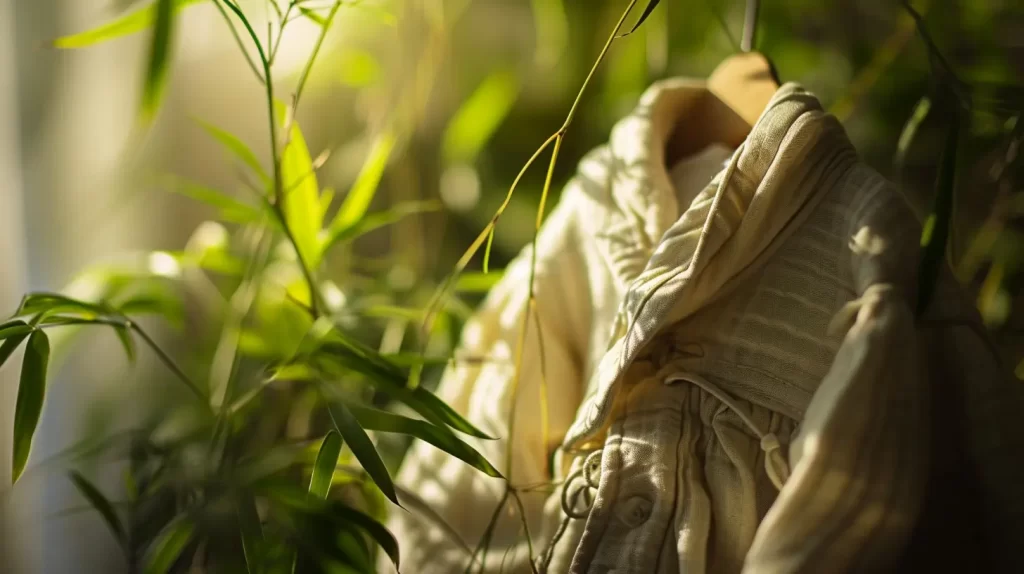
As you care for your little one’s bamboo garments, it’s essential to consider the environmental footprint of your laundry routine. Choosing eco-friendly 🌎 detergents isn’t just better for the fabric, but it also lessens the strain on our planet. Let’s explore how sustainable practices in washing and maintaining bamboo baby clothes can contribute to a greener future. ♻️
Using Eco-Friendly Laundry Detergent for Bamboo Clothes
In the journey of sustainable care for bamboo baby clothes, selecting the right eco-friendly laundry detergent plays a pivotal role. It’s a choice that benefits not only the fabric but also the environment, contributing to a healthier planet for future generations. Here’s a more detailed guide on why eco-friendly detergents are essential and how they impact the care of bamboo fabrics:
- Biodegradable Ingredients: Eco-friendly detergents typically contain ingredients that are biodegradable, meaning they break down naturally in the environment. This significantly reduces water pollution, ensuring that our rivers, lakes, and oceans are spared from harmful chemical residues.
- Reduced Chemical Footprint: By avoiding harsh chemicals like phosphates, chlorine, and synthetic fragrances, eco-friendly detergents lessen the risk of chemical exposure. This is not only beneficial to the environment but also crucial for your baby’s health. Bamboo fabrics washed in such detergents retain their natural softness and are less likely to cause skin irritations or allergies.
- Gentle on Bamboo Fibers: Eco-friendly detergents are formulated to be gentle on delicate fabrics like bamboo. They effectively clean without compromising the fabric’s integrity, maintaining its durability and softness over time.
- Energy-Efficient Washing: These detergents are often effective in cold water washes, which aligns perfectly with the recommended washing temperature for bamboo clothes. This synergy results in energy conservation, as cold water washes require less energy compared to hot water cycles.
- Supporting Sustainable Brands: Choosing eco-friendly detergents often means supporting companies that prioritize sustainability and ethical practices. This includes responsible sourcing of ingredients, environmentally friendly manufacturing processes, and packaging that reduces waste.
- Concentration and Efficiency: Many eco-friendly detergents come in concentrated forms, meaning you use less product per wash. This not only reduces packaging waste but also the frequency of purchasing new detergent, making it a cost-effective and sustainable option.
- Long-term Environmental Impact: Regular use of eco-friendly detergents contributes to a larger movement of environmental stewardship. It’s a simple yet impactful way to play a part in preserving the planet’s health for future generations.
In summary, using eco-friendly laundry detergent for washing bamboo clothes aligns with a holistic approach to environmental conservation. It’s a choice that reflects care and consideration for your baby’s health, the longevity of their garments, and the well-being of our planet.
The Bigger Picture: Sustainable Care for Bamboo
Embracing sustainable care practices for bamboo baby clothes extends far beyond the choice of detergent. It involves a holistic consideration of the environmental impact of your entire laundry routine. This broader view is essential in ensuring that the eco-friendly nature of bamboo is fully realized in its care. Here’s an expanded perspective on sustainable care for bamboo fabrics:
- Conservation of Water and Energy: Recognize that each washing cycle, regardless of the material, uses water and energy. For bamboo clothes, which are derived from a sustainable resource, it’s crucial to continue this eco-conscious approach in their maintenance. Opting for cold water wash cycles significantly reduces energy consumption, as the majority of energy in washing machines goes towards heating water.
- Mindful of Frequency: Consider the frequency of your washes. Washing bamboo clothes only when necessary helps in conserving water and reducing wear and tear on the fabric. This not only extends the life of the garments but also aligns with sustainable living principles.
- Maximizing Load Efficiency: When you do use the washing machine, make sure to wash a full load. This practice maximizes the efficiency of the water and energy used per wash. It’s a simple yet effective way to ensure that every wash cycle is as environmentally friendly as possible.
- Air-Drying Practices: Whenever possible, choose to air-dry bamboo baby clothes. This natural method not only preserves the quality of the fabric but also eliminates the carbon emissions associated with electric dryers. Air-drying is gentle on clothes and the environment, further enhancing the sustainable nature of bamboo fabrics.
- Reducing Carbon Footprint: Each step taken to minimize energy use in your laundry routine contributes to a lower carbon footprint. This conscious effort helps in combating climate change, ensuring a healthier planet for future generations.
- Promoting Eco-friendly Habits: By adopting and sharing these eco-friendly laundry habits, you encourage a culture of sustainability. This influence can extend beyond personal practice, inspiring others to adopt similar habits and thereby amplifying the positive environmental impact.
- Comprehensive Sustainable Approach: Sustainable care for bamboo baby clothes is a commitment that goes hand in hand with the ethos of choosing bamboo as a material. It reflects a comprehensive approach to sustainability, encompassing the lifecycle of the product from production to maintenance.
In essence, the way you care for bamboo baby clothes can have a significant environmental impact. By adopting these sustainable practices, you’re not just caring for your child’s clothes; you’re contributing to the preservation and well-being of the planet they will inherit.
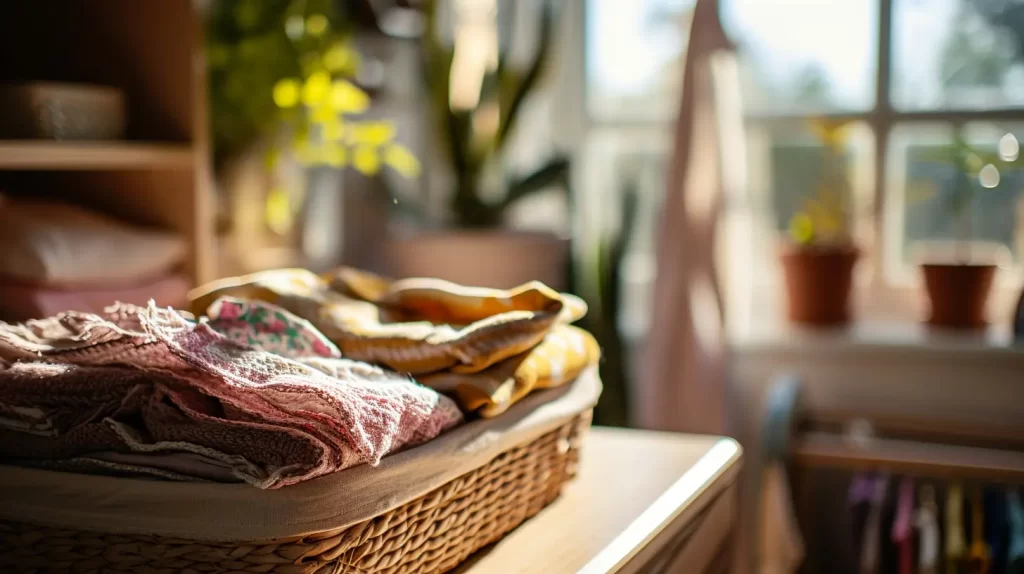
Conclusion: Taking Care of Those Baby Bamboo Clothes
Let’s put a bow on it. 🎀 Caring for bamboo baby clothes is more than a routine chore; it’s a nurturing act that extends the love you have for your little one to their clothing. By following the guidance provided, you’re ensuring that each garment remains as soft, durable, and eco-friendly as the day you first chose it. Embrace these practices as a way to cherish and protect, not just the fabric, but the environment your child will grow up in. Happy laundering on this journey of sustainable and loving care for your bamboo-clad bundle of joy! 🌱💚👶

Bamboo FAQ
Q: How do I properly wash bamboo baby clothes?
A: Wash bamboo baby clothes in cold water on a gentle cycle. Use a mild, eco-friendly detergent designed for delicate fabrics. Avoid bleach and fabric softeners to preserve the fabric’s natural qualities.
Q: What are the benefits of washing bamboo clothes?
A: Proper washing retains bamboo clothes’ inherent softness, breathability, and durability. It ensures the fabric maintains its hypoallergenic and antimicrobial properties, keeping it safe and comfortable for sensitive skin.
Q: How can I prevent pilling on bamboo baby clothes?
A: To prevent pilling, turn bamboo clothes inside out before washing and avoid high agitation in the wash. Use a gentle, liquid detergent and wash with similar soft fabrics.
Q: Can I use regular laundry detergent for washing bamboo clothes?
A: It’s best to use a gentle, liquid detergent that’s free from harsh chemicals. Regular detergents can be too abrasive for bamboo fabric and may degrade its natural softness and strength.
Q: How do I take care of my bamboo baby clothes to ensure they last longer?
A: Care for bamboo baby clothes by washing in cold water with a gentle detergent, avoiding bleach and fabric softeners, and air drying if possible. Also, handle stains promptly and store the clothes properly.
Q: Can I pre-treat stains on bamboo clothes before washing them?
A: Yes, pre-treat stains on bamboo clothing with a mild, eco-friendly stain remover. Apply gently without rubbing harshly to avoid damaging the fabric fibers.
Q: How should I store bamboo baby clothes to keep them in good condition?
A: Store bamboo baby clothes in a dry, cool place, away from direct sunlight. Ensure they are completely dry before storing to avoid mildew growth. Fold them gently to avoid creasing.
Q: Do bamboo clothes resist stains effectively?
A: Bamboo clothes offer a natural resistance to staining due to their smooth fibers. However, prompt stain treatment is advised to maintain their appearance and quality.
Q: How does the fabric of bamboo baby clothes help regulate temperature?
A: Bamboo fabric is naturally breathable and moisture-wicking, helping to regulate body temperature. It keeps the wearer cool in warm conditions and warm in cooler conditions, ensuring comfort for your baby.


